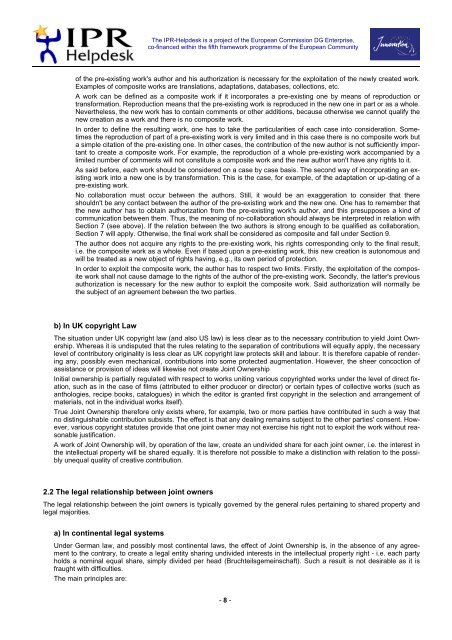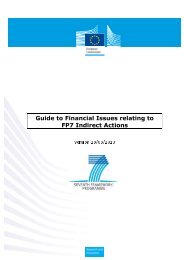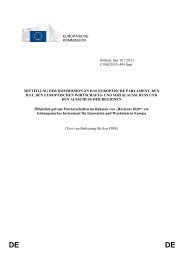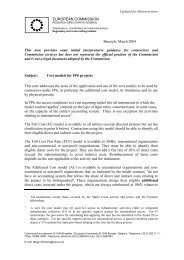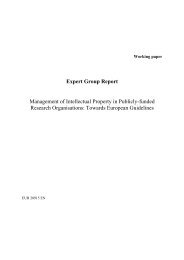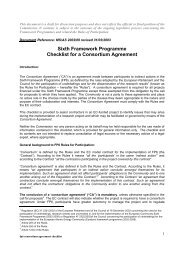Joint Ownership in Intellectual Property Rights - KoWi
Joint Ownership in Intellectual Property Rights - KoWi
Joint Ownership in Intellectual Property Rights - KoWi
You also want an ePaper? Increase the reach of your titles
YUMPU automatically turns print PDFs into web optimized ePapers that Google loves.
The IPR-Helpdesk is a project of the European Commission DG Enterprise,<br />
co-f<strong>in</strong>anced with<strong>in</strong> the fifth framework programme of the European Community<br />
of the pre-exist<strong>in</strong>g work's author and his authorization is necessary for the exploitation of the newly created work.<br />
Examples of composite works are translations, adaptations, databases, collections, etc.<br />
A work can be def<strong>in</strong>ed as a composite work if it <strong>in</strong>corporates a pre-exist<strong>in</strong>g one by means of reproduction or<br />
transformation. Reproduction means that the pre-exist<strong>in</strong>g work is reproduced <strong>in</strong> the new one <strong>in</strong> part or as a whole.<br />
Nevertheless, the new work has to conta<strong>in</strong> comments or other additions, because otherwise we cannot qualify the<br />
new creation as a work and there is no composite work.<br />
In order to def<strong>in</strong>e the result<strong>in</strong>g work, one has to take the particularities of each case <strong>in</strong>to consideration. Sometimes<br />
the reproduction of part of a pre-exist<strong>in</strong>g work is very limited and <strong>in</strong> this case there is no composite work but<br />
a simple citation of the pre-exist<strong>in</strong>g one. In other cases, the contribution of the new author is not sufficiently important<br />
to create a composite work. For example, the reproduction of a whole pre-exist<strong>in</strong>g work accompanied by a<br />
limited number of comments will not constitute a composite work and the new author won't have any rights to it.<br />
As said before, each work should be considered on a case by case basis. The second way of <strong>in</strong>corporat<strong>in</strong>g an exist<strong>in</strong>g<br />
work <strong>in</strong>to a new one is by transformation. This is the case, for example, of the adaptation or up-dat<strong>in</strong>g of a<br />
pre-exist<strong>in</strong>g work.<br />
No collaboration must occur between the authors. Still, it would be an exaggeration to consider that there<br />
shouldn't be any contact between the author of the pre-exist<strong>in</strong>g work and the new one. One has to remember that<br />
the new author has to obta<strong>in</strong> authorization from the pre-exist<strong>in</strong>g work's author, and this presupposes a k<strong>in</strong>d of<br />
communication between them. Thus, the mean<strong>in</strong>g of no-collaboration should always be <strong>in</strong>terpreted <strong>in</strong> relation with<br />
Section 7 (see above). If the relation between the two authors is strong enough to be qualified as collaboration,<br />
Section 7 will apply. Otherwise, the f<strong>in</strong>al work shall be considered as composite and fall under Section 9.<br />
The author does not acquire any rights to the pre-exist<strong>in</strong>g work, his rights correspond<strong>in</strong>g only to the f<strong>in</strong>al result,<br />
i.e. the composite work as a whole. Even if based upon a pre-exist<strong>in</strong>g work, this new creation is autonomous and<br />
will be treated as a new object of rights hav<strong>in</strong>g, e.g., its own period of protection.<br />
In order to exploit the composite work, the author has to respect two limits. Firstly, the exploitation of the composite<br />
work shall not cause damage to the rights of the author of the pre-exist<strong>in</strong>g work. Secondly, the latter's previous<br />
authorization is necessary for the new author to exploit the composite work. Said authorization will normally be<br />
the subject of an agreement between the two parties.<br />
b) In UK copyright Law<br />
The situation under UK copyright law (and also US law) is less clear as to the necessary contribution to yield <strong>Jo<strong>in</strong>t</strong> <strong>Ownership</strong>.<br />
Whereas it is undisputed that the rules relat<strong>in</strong>g to the separation of contributions will equally apply, the necessary<br />
level of contributory orig<strong>in</strong>ality is less clear as UK copyright law protects skill and labour. It is therefore capable of render<strong>in</strong>g<br />
any, possibly even mechanical, contributions <strong>in</strong>to some protected augmentation. However, the sheer concoction of<br />
assistance or provision of ideas will likewise not create <strong>Jo<strong>in</strong>t</strong> <strong>Ownership</strong><br />
Initial ownership is partially regulated with respect to works unit<strong>in</strong>g various copyrighted works under the level of direct fixation,<br />
such as <strong>in</strong> the case of films (attributed to either producer or director) or certa<strong>in</strong> types of collective works (such as<br />
anthologies, recipe books, catalogues) <strong>in</strong> which the editor is granted first copyright <strong>in</strong> the selection and arrangement of<br />
materials, not <strong>in</strong> the <strong>in</strong>dividual works itself).<br />
True <strong>Jo<strong>in</strong>t</strong> <strong>Ownership</strong> therefore only exists where, for example, two or more parties have contributed <strong>in</strong> such a way that<br />
no dist<strong>in</strong>guishable contribution subsists. The effect is that any deal<strong>in</strong>g rema<strong>in</strong>s subject to the other parties' consent. However,<br />
various copyright statutes provide that one jo<strong>in</strong>t owner may not exercise his right not to exploit the work without reasonable<br />
justification.<br />
A work of <strong>Jo<strong>in</strong>t</strong> <strong>Ownership</strong> will, by operation of the law, create an undivided share for each jo<strong>in</strong>t owner, i.e. the <strong>in</strong>terest <strong>in</strong><br />
the <strong>in</strong>tellectual property will be shared equally. It is therefore not possible to make a dist<strong>in</strong>ction with relation to the possibly<br />
unequal quality of creative contribution.<br />
2.2 The legal relationship between jo<strong>in</strong>t owners<br />
The legal relationship between the jo<strong>in</strong>t owners is typically governed by the general rules perta<strong>in</strong><strong>in</strong>g to shared property and<br />
legal majorities.<br />
a) In cont<strong>in</strong>ental legal systems<br />
Under German law, and possibly most cont<strong>in</strong>ental laws, the effect of <strong>Jo<strong>in</strong>t</strong> <strong>Ownership</strong> is, <strong>in</strong> the absence of any agreement<br />
to the contrary, to create a legal entity shar<strong>in</strong>g undivided <strong>in</strong>terests <strong>in</strong> the <strong>in</strong>tellectual property right - i.e. each party<br />
holds a nom<strong>in</strong>al equal share, simply divided per head (Bruchteilsgeme<strong>in</strong>schaft). Such a result is not desirable as it is<br />
fraught with difficulties.<br />
The ma<strong>in</strong> pr<strong>in</strong>ciples are:<br />
- 8 -


